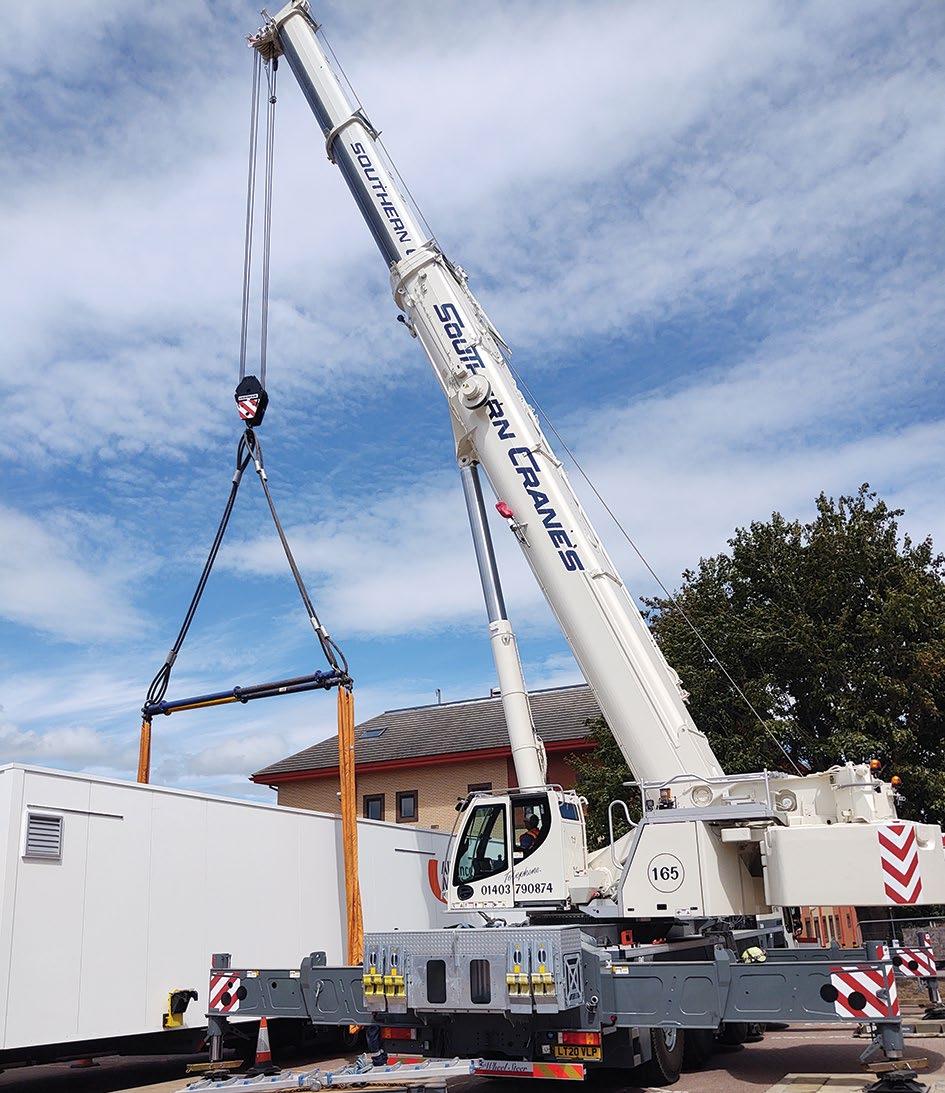remote controls
c&a A lot of work was required to develop the drive and braking functions
The system uses augmented reality overlay images to help notify operators of various points of interest
Successful trial As part of site trails UltraWis worked with Liebherr’s Israeli distributor Top Engineering to install its system on a five tonne Liebherr 71 EC-B tower crane on a construction site near Hadera, north of Tel Aviv. The training of the tower crane operator took place within the ground cab and involved a series of theory and video based learning before hands on training on the remote system. “The system is very intuitive and after only 10 hours of using WideSite the operator informed us that he no longer wanted to return to the tower crane cab to work anymore!” During the trial the company encountered a small number of challenges – chiefly around the level of vibration that occurs when lifting a load at the end of the jib which distorted the view. The addition of inertial measuring units (IMU) combined with a new algorithm however proved more than capable of stabilising the images. Avitan goes on to explain how the trials also provided a number of unexpected benefits. “Our sensing unit has two cameras on either ends of the jib which provide 360 degrees of sight essentially providing visibility of the entire site. As such we are able to monitor the whole area and have started pushing it out to cloud and mobile applications to give
When millimetres count customers visibility of the site as it progresses.” More than just providing a live feed of the site however the high tech motion detection system is able to track employee and equipment movements and, if required, notify management on a range of things like whether or not a person is wearing his safety helmet or hi-vis vest. It is also able to provide a heat map of where personnel have been located each day.
Product rollout Following its successful trial in Israel, the company is looking to carry out further trials in Europe and the USA and is holding advanced discussions with a leading - but unnamed - manufacturer, while also looking to target end users and rental companies by the beginning of next year. Although the system is now available on tower cranes the company says that WideSite can be installed on a range of cranes, such as overhead gantry, marine and ship to shore cranes. As well as providing benefits in safety and productivity for a number of industries the company is also hoping that it might play a role in reducing the risks of lone workers. By having crane operators working from the ground and closer to others on site, it effectively eliminates the need to have complicated rescue and additional safe systems of work in place.
The system can be used to provide visibility and monitoring functions of the site in both 2D and 3D
44 cranes & access November 2020
For a while now mobile crane manufacturers have offered remote control systems for setting up the crane and some boom movements – and in some cases boom movements of multiple cranes – however, in general they have not been capable of operating the crane chassis. That changed last year with the introduction of Liebherr’s new RemoteDrive system - available on its 50 tonne LTC 1050-3.1 - which was developed in partnership with German crane rental company Salgert. By allowing the crane chassis to be driven from outside the cab, the new system offers the operator greater flexibility and improved visibility on job sites with limited space, such as the inside of an industrial facility. It also means the operator has a full view of the situation eliminating the need for a banksman. Salgert managing director, Wolfgang Salgert, originally approached Liebherr to design such a system after constantly encountering restricted jobsites that relied solely on the operators view from the cab and camera systems. He says: “I had been looking for a way of controlling our LTC compact cranes by remote for many years. They perform 70 percent of their work inside or around industrial buildings where there is limited space. This means that we face situations every day where the crane operator cannot see the whole
Liebherr’s RemoteDrive system is the first to remotely control a crane chassis
picture.” After receiving similar feedback at Liebherr’s Customer Days and following subsequent interest in the concept of the RemoteDrive system, Liebherr felt there was enough potential demand to turn the concept into reality.
Persistence pays off Although the RemoteDrive only required additional software on the crane and two master switches on the company’s LICCON2 remote control system, its development was far from straight forward. Philipp Mang of Liebherr recalls the challenges: “Transferring all the required displays and controls for the operator from the cab to the remote controller posed challenges for us. We wanted to make sure that the machine could be operated as intuitively as possible, and above all safely. That meant that we had to get really creative.” Particular attention was required on the drive function as well as the ability to brake the vehicle safely which resulted in the addition of an electric braking valve. Armin Geiss from Liebherr’s technical testing department, adds: “There were lots of different versions before we finally came up with a solution for improving the intuitive control and displays. Initially we expected that manoeuvring in first gear would deliver the greatest sensitivity. But in fact we found that using a higher














